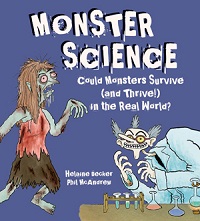| ________________
CM . . .
. Volume XXIII Number 15. . . .December 16, 2017
excerpt:
Who would imagine a book about monsters that would also be about science? When I first saw the title of Monster Science and the images on the cover (a zombie and stereotypical “mad” scientist), I wasn’t immediately certain that I would enjoy reading and reviewing this book. Author Helaine Becker, however, captivated me with her ability to combine folklore, myths, and hoaxes with literary history, social history, and events from the history of science, as well as science knowledge, and contemporary science research. It’s an amazing feat, and for youth interested in monsters and those who may wonder if such creatures could actually live in the real world, Monster Science is likely to be of great interest. Eighty-nine of the ninety-six pages of Monster Science are divided into six sections: one for each kind of monster. These are Dr. Frankenstein’s monster, vampires, Bigfoot, zombies, werewolves, and sea monsters. The remaining pages include the title page, dedication, acknowledgement, and copyright page, table of contents, introduction, and two-page index. The contents associated with each monster are varied as a result of the applicable topics addressed. Each section, however, begins with an image of the monster presented in a scientific-like diagram with labels that describe its most significant parts and ends with a test of the material presented. For example, readers will know that a vampire, looking very much like a cross between Count von Count on Sesame Street and Bela Lugosi’s portrayal of Count Dracula, has a “widow’s peak”, “deathly pallor”, “fangs”, “keen fashion sense”, “coffin for daytime snoozing”, “cape (optional)”, “hypnotic eyes”, and is “obsessed with counting.” Sea monsters, on the other hand, such as Nessie and the Kraken, are simply described as “extremely elusive” because there are few, if any, photographs that have been taken of them. The review test for vampires is composed of eight multiple-choice questions, and the sea monster test requires true or false responses to 10 statements. Other assessment approaches include matching (e.g., moon with tides and chromosomes with DNA) and responses to closed questions. In the 18 page section on Bigfoot, Becker identifies other “mysterious, wild, humanlike creatures” found in myths and legends, including the Chinese “Yeren” that she compares to a humanlike bear, the “Yeti”/”Abominable Snowman” in Nepal, and the half human, half goat “faun” in myths from the Middle Ages. She then addresses hoaxes and made-up sightings of Bigfoot and Yeti before moving into science where cryptids (plants and animals that have not been officially identified and named), cryptozoologists (see third excerpt above), and the taxonomic system developed by Carl Linnaeus are described. This is followed with information on early hominids, Charles Darwin’s theory of evolution by natural selection, hybrids, confirmation bias, placebos, low oxygen environments, and optical illusions. In contrast, the 12 pages on werewolves, begin with a brief history of “were-animals” and the real and imaginary powers attributed to Earth’s Moon. This includes an explanation for the reason wolves appear to be howling at a full moon. Becker then describes the trials of witches during the Inquisition, particularly those that were thought to shape shift into wolves, and the methods one could use to stop a werewolf. She then looks at the science of hybridization, Mendel’s crossbreeding of peas with different characteristics, the Punnett square, chromosomes, and the impossibility of a chimp-human and a wolf-human hybrid, even such a hybrid that is genetically engineered. The section ends with information about the evolution of dogs from wolves and diseases and genetic disorders with symptoms that mimic werewolf traits. At the end of these and the remaining four sections of Monster Science, readers will not only be able to discuss the topics just identified, but they will be able to answer questions about Mary Shelley’ novel Frankenstein, electricity and the historical arguments related to electricity as a source of life, the defibrillator, the nervous system, organ transplants, William Harvey’s study of the heart and blood circulation, the likelihood of a blood diet being nutritious, the possibility of immortality, the origin of the zombie, sonar, ocean trenches, tsunamis, and much, much more. As suggested by the final excerpt above, Becker also provides information in brief statements titled “Monster Facts” and in large and small text boxes with headings such as “Electricity and Your Muscles” and “Warm-blooded vs. Cold-blooded Creatures”. Each page is illustrated with one or more colourful, cartoon-like images created by Phil McAndrew. With the exception of information presented in a timeline, table, and map, and the scientific diagrams of objects such as a voltaic pile, neutron and family tree of Homo sapiens, McAndrew’s images are amusing and a complement to Becker’s text. Monster Science is a highly recommended for all readers with an interest in developing a scientific understanding of frightening and mysterious beings and beasts. Highly Recommended. Barbara McMillan is a teacher educator in the Faculty of Education at the University of Manitoba in Winnipeg, MB.
To comment
on this title or this review, send mail to cm@umanitoba.ca.
Copyright © the Manitoba Library Association. Reproduction for personal
use is permitted only if this copyright notice is maintained. Any
other reproduction is prohibited without permission.
Next Review | Table of Contents For This Issue - December 16, 2016 |
